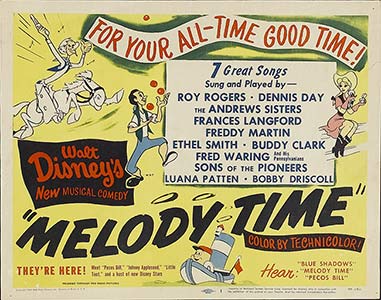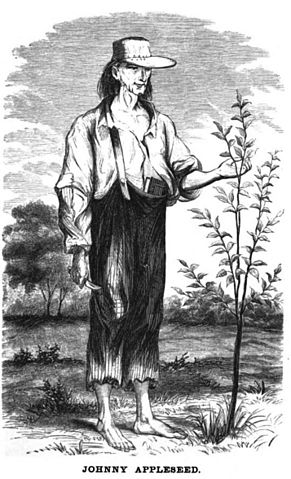Welcome to Revisiting Disney! Today, we’re looking at the third of the four anthology movies that were made after World War II, Melody Time! Because the next few films are collections of shorts, the format is a little different (I’ve moved the Plot and Source Material to the Animation section, similar to Fantasia).
Of course, I have labeled each category so if you want to skip to the parts that interest you most, feel free. And, of course, if you have any thoughts, burning or otherwise, please share in the comments!
BACKGROUND
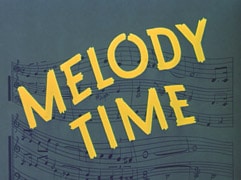
Photo: Disney
Melody Time, like many of the anthology films, seems to have been largely ignored in the animation histories. This may be because they were created at a time when the studio couldn’t actually afford to make a full-length feature. Because of this, they can be seen as an embarrassing reminder of that less than grand time in the Studio’s history. Historian Christopher Finch says that “a true animated feature would have taken too long to make and would have eaten up too much of the reserves at this point, so other solutions had to be found” (Finch 1975: 115).
Adrian Bailey and Christopher Finch both just mention Melody Time by name as part of the Disney canon, putting the film as one of the “anthology features” that were released after the War, coming out after Song of the South and before Cinderella.
This is the third of the post-War films that Disney made, around the same time as Song of the South. Like Make Mine Music, Melody Time is just a lot of fun, using popular musicians of the day matched with beautiful and fun animation. And also like Make Mine Music, Melody Time reminded me of Fantasia, but a Fantasia that takes itself less seriously. It premiered on May 27th, 1948.
MUSIC
Melody Time is made up of seven short segments, and, like Make Mine Music uses modern musical pieces and modern stars. Bob Thomas calls Melody Time “another musical smorgasbord with pop performers” (Thomas 1992: 99). Musicians in this piece include Ethel Smith, The Andrews Sisters, The Dinning Sisters, Roy Rogers and the Sons of the Pioneers, Dennis Day, Fred Waring and his Pennsylvanians, and Freddy Martin and his Orchestra. Bobby Driscoll and Luana Patten also were involved in the live-action sequence.
Since both Driscoll and Patten were famous child stars, Roy Rogers and Trigger were Roy Rogers and Trigger, and the rest of the musical talent was famous as well, this film was packed with star power and modern music.
ANIMATION
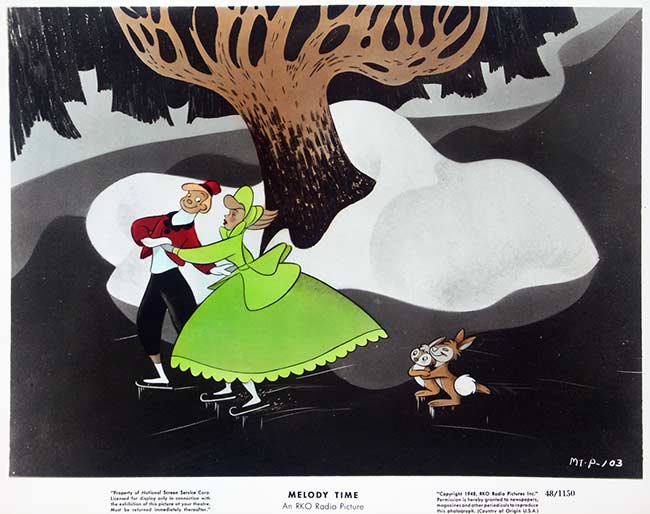
Like in Make Mine Music, there is a wide animation style; each segment is unique. It also looks like they had a lot of fun making this film, and from what I can tell, it wasn’t as favorably received as the other pieces released in the late 1940s. And like some of the other films made in the mid-40s, there are a few minutes shaved off of the time. My VHS is 75 minutes, while IMDB lists the running time at 72 minutes. The “Pecos Bill” segment had some shots where Pecos was smoking, these were removed later on.
RELATED: Revisiting Disney: Make Mine Music
This film was never released as part of the Disney Classics Collection but was released onto VHS for the first time on March 10th, 1999 as part of the Walt Disney Masterpiece Collection. Critically speaking, the Amazon.com product description is fairly glowing, implying that, despite its rocky start, this film is remembered today (when it is remembered) positively.
The Directing Animators were Eric Larson, Ward Kimball, Milt Kahl, Ollie Johnston, Les Clark and John Lounsbery, some of the Nine Old Men (I always like seeing their names in the early films). Additionally, Mary Blair worked on Color and Styling.
The opening number is musical, a lovely rendition of “Melody Time” with the opening credits played over sheet music. Between segments, there is a disembodied hand with a brush, but the whole thing is started with this song, a set of masks and the opening of a curtain. Like with Make Mine Music, it sets things up as a concert feature (but, unlike Fantasia, this one has Roy Rogers and the Andrews Sisters). Buddy Clark serves as the Master of Ceremonies.
RELATED: Revisiting Disney: Fantasia
“Once Upon a Wintertime”
This piece is sung by Frances Langford (she worked with Bob Hope and was also in Yankee Doddle Dandy) and features two couples, one human and one rabbit, on their adventures in the winter. The piece opens with the human couple on a sleigh ride, picking up two birds, squirrels and a rabbit couple. The boy human and rabbit proceed to teach their ladies how to ice skate, but manage to make them angry by spraying them with snow and laughing at them. In their huff, the ladies miss the “Thin Ice Sign” and the boy rabbit’s attempt to warn them cracks the ice, sending both ladies headed toward a waterfall (they both faint).
The boys are unable to reach their ladies and become trapped in the ice. Luckily, the other animals step up and are able to save the day. The two couples’ stories parallel each other nicely. The music is fun, but this story is very perilous for a Disney short. Two characters almost go over a waterfall; it summarizes everything I was ever afraid of with regard to ice skating as a kid (though I was not actually near a waterfall).
“Bumble Boogie”
Freddy Martin, his orchestra and with Jack Fina play this next piece, a variation of “The Flight of the Bumblebee.” I love this piece, not only because of the music but because the animation is just delightful. The little bumblebee finds himself trapped in a world where everything is a musical instrument that is also out to get him. The piano monster, made up of keys, is particularly determined, though the brass instruments are likewise troublesome to our little flying hero. Overall, it’s just really fun and whimsical.
“Johnny Appleseed”

Photo: Disney
Performed by Dennis Day, this is one of my favorite shorts from this anthology. Unlike the other pieces, this one opens with a book, placing Johnny in his place in American Mythology. The animation is beautiful; each background could be a painting (though to be honest, technically it is. You know what I mean).
The music is fun and builds the world of the West though I think it might be a little optimistic in the power of the apple trees in bringing people together. This piece is also fun because either Chip or Dale makes an appearance as one of Johnny’s woodland friends. The singing prayer, called the Johnny Appleseed Prayer, weaves its way through the piece, either sung by Johnny or as part of the background.
Although the ending is a bit bittersweet, I found myself loving this segment. I like how it explains a particular shape of clouds, and reminds us all that even the smallest person can make a difference and cast a very large shadow. “Johnny Appleseed” would later be added to the “American Legends” film that was made in 2002. This film is also one that everyone should check out; the “John Henry” short will make you cry.
“Little Toot”
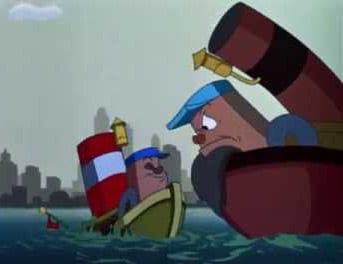
Photo: Disney
The story of “Little Toot” was written by Hardie Gramatky and sung by The Andrews Sisters, who sang “Johnnie Fedora and Alice Bluebonnet” in Make Mine Music. “Little Toot” is the story of a little tugboat who lived in New York harbor with his father, Big Toot. Unfortunately, Little Toot is always getting into trouble, holding up traffic, submerging his dad by mistake, blowing smoke on clean liners, and other mischievous acts. One day, he accidentally drove an ocean liner onto the shore. This caused shame for his family and a disaster for his harbor, and he is exiled twelve miles off shore as a result. While there, he was able to save a giant ocean liner and learn the importance of working hard for a tugboat. It’s a super cute story, and Little Toot is the most adorable boat ever.
“Trees”
This piece is performed by Fred Waring and his Pennsylvanians and is an arrangement of a poem by Joyce Kilmer that was put to music by Oscar Rasbach. The poetry is lyrical and the animation reminds me of Bambi; they were clearly going for lifelike and it works. The focus is on a tree and the environment that it impacts. The piece looks at several seasons and a variety of weather, with some very impressive rain. It’s a beautiful segment, in both animation and music.
“Blame it on the Samba”
In this piece, Donald Duck and Jose Carioca are depressed, but thanks to their mischievous friend from The Three Caballeros, the Aracuan, they find themselves cured. This is thanks to the rhythm of the samba, the talented work of Ms. Ethel Smith on the organ and the singing of The Dinning Sisters. The piece combines live action in the form of Ms. Smith and her amazing organ playing, and the interactions she has with our three intrepid birds. This piece is fun, though it’s a little out there in some ways (they meet Ms. Smith when the Aracuan makes a cocktail that he mixes them into. In that glass is Ethel and her organ). Her playing is amazing; it’s worth watching the whole film just to see the way her fingers fly over the keys and her feet fly over the pedals. This piece is fun despite some strangeness; it’s brightly colored with music you have to tap your toes to.
“Pecos Bill”
This piece is so much fun, but I can’t be sure how much of that is from the piece and how much is because of my love of Roy Rogers, his singing and Westerns in general. This piece is sung by Roy and Bob Nolan and the Sons of the Pioneers and was introduced in a really fun sequence that was combined animation and live-action. This intro featured Roy Rogers, Trigger and Bob Nolan and the Sons of the Pioneers.
We start with an animated sequence to “Blue Shadows” before arriving at a campsite. The group is camping out with child stars Bobby Driscoll (who had been in Song of the South, other live action films and would go on to voice Peter Pan in Peter Pan) and Luana Patten (who we saw in Fun and Fancy Free and also appeared in Song of the South and other live action Disney films).

Photo: Disney
Luana has a question about why coyotes howl at the moon and when Roy tells her that it’s a story about Pecos Bill, they are all surprised to learn that Bobby (a self-proclaimed cowboy fan) has never heard of Pecos. To fix this, they decide to tell the kids the story, starting at the beginning. The short outlines the legend of Pecos Bill, his horse Widowmaker and Pecos’ love, and the ill-fated Slue Foot Sue.
RELATED: Revisiting Disney: Fun and Fancy Free
The 1940’s
Like last week, some things haven’t changed. Since the other two compilation films, or package films, had done so well (Saludos Amigos and The Three Caballeros were popular in their day), this showed the Studio a way to continue making quality product with limited resources and limited manpower. The strike and the War had taken a toll on the Studio. Adrian Bailey points out that these films, plus the live action/animation hybrid The Song of the South, were more like “mere stepping stones” to Cinderella (Bailey 1982: 179).
Bob Thomas calls the films from this era “the anthology features” and says that “the company was deeply in debt. Unable to finance a new feature like Snow White or Pinocchio, Disney launched a series of economical films that brought little glory but much-needed income to the studio” (Thomas 1992:99). Basically, Disney was trying to make money to keep afloat and the result is a series of films that I think are seriously underrated.
The lessons learned, which are listed below, are all things that were seen as very positive in the late 40s (and today too). This, to me, is the best tie-in from the Era. The emphasis on Pecos Bill and Johnny Appleseed are a way to call back to the good old days, America’s own mythology and something that we could strive to be.
The 1940s can also be seen in the way that the Native Americans are portrayed, particularly in the “Pecos Bill” segment. It’s very brief, but very stereotypical of the 1940s and ’50s (and in such a way as to make me say, “Come on Disney, you can do better than that”). We’ll get more into that topic when we hit Peter Pan, but even though Disney was just acting like every other studio at the time, I feel like they were trendsetters and should have used their powers for good.
LESSONS LEARNED
From “Johnny Appleseed,” I learned about the importance of faith, kindness and courage. Johnny was afraid to go West because he wasn’t the typical pioneer. His guardian angel reminded him that really, he had faith, courage and kindness, so there was nothing he couldn’t do. Johnny set out with his apple seeds, his Bible and a pot for a hat. As he traveled, he not only planted apple trees, he planted kindness. The animals loved him, his orchards brought people together as well, and his work was always accompanied by his praising God.
The other lesson from “Johnny Appleseed” is that no one is too small to make a difference. Not only did Johnny make a difference in the lives and places he encountered, the little skunk was not as big as the bear or the cougar, but he was chosen to drive away the potentially dangerous human because of his unique skill set.
From “Once Upon a Wintertime,” I learned the importance of always checking for signs and being aware of my surroundings.
From “Little Toot,” I learned that there is a time for work and a time for play and that the way you know you’ve grown up is when you can tell the difference. Just like Little Toot had to grow up to become a functional member of his harbor (and save the ocean liner during the storm), all little kids, at some point, become useful members of society who know when the time to play is and don’t confuse it with the time to work.
From “Pecos Bill,” I learned to not be cocky. Sue thought she could ride a horse that hated her while wearing a bustle, and, as a result, was trapped on the moon forever. I also learned from Widowmaker that you have to let people you love make their choices. Widowmaker interfered in Pecos and Sal’s courtship and wedding, and, as a result, the person he cared most about, Pecos, was miserable for the rest of his life.
DOES IT HOLD UP?
I would call this piece another of the forgotten gems of the 1940s. The shorts are fun in their own ways, the music is catchy and all the animation still looks good today. If you haven’t seen this, it’s definitely worth the 75 or 72 minutes it will take to watch it (depending on which version you have). It’s on Amazon instant video, so check it out!
For next week: The Adventures of Ichabod and Mr. Toad
If you enjoyed this post and the others in the Revisiting Disney series, and have found yourself wishing that you could find them all in one convenient and bound book with eight extra essays, there is an option for you! Check out A Journey Through Disney: My Look Back Through Disney Canon, now available on Amazon as both a Kindle book ($4.99) and a paperback ($11.99).
OTHER SOURCES:
https://thewaltdisneycompany.com/about-disney/disney-history
http://www.imdb.com
http://studioservices.go.com/disneystudios/history.html
Bailey, Adrian. Walt Disney’s World of Fantasy. Everest House Publishers. New York, New York. 1982.
Dower, John W. War Without Mercy: Race and Power in the Pacific War. Pantheon Books. New York, New York. 1986.
Finch, Christopher. The Art of Walt Disney: From Mickey Mouse to the Magic Kingdom. Harry N. Abrams, Inc. New York, New York. 1975.
Sale, Roger. Fairy Tales and After: From Snow White to E.B. White. Harvard University Press. Cambridge, MA, 1978.
Tatar, Maria. The Annotated Classic Fairy Tales. W.W. Norton and Company. New York and London, 2002.
Thomas, Bob. Disney’s Art of Animation From Mickey Mouse to Hercules. Hyperion. New York, New York. 1992.
Wright, Gordon. The Ordeal of Total War: 1939-1945. Harper Torchbooks, Harper & Row. New York, Hagerstown, San Francisco, and London, 1968.
ARE YOU A ROMANCE FAN? FOLLOW THE SILVER PETTICOAT REVIEW:
 Our romance-themed entertainment site is on a mission to help you find the best period dramas, romance movies, TV shows, and books. Other topics include Jane Austen, Classic Hollywood, TV Couples, Fairy Tales, Romantic Living, Romanticism, and more. We’re damsels not in distress fighting for the all-new optimistic Romantic Revolution. Join us and subscribe. For more information, see our About, Old-Fashioned Romance 101, Modern Romanticism 101, and Romantic Living 101.
Our romance-themed entertainment site is on a mission to help you find the best period dramas, romance movies, TV shows, and books. Other topics include Jane Austen, Classic Hollywood, TV Couples, Fairy Tales, Romantic Living, Romanticism, and more. We’re damsels not in distress fighting for the all-new optimistic Romantic Revolution. Join us and subscribe. For more information, see our About, Old-Fashioned Romance 101, Modern Romanticism 101, and Romantic Living 101.

